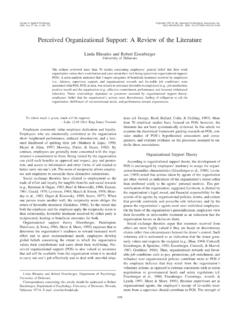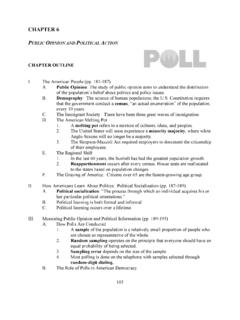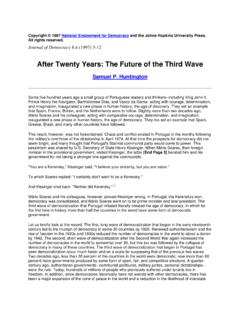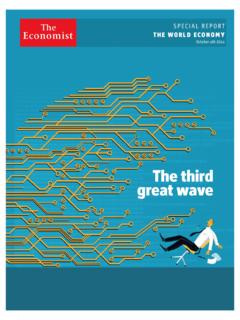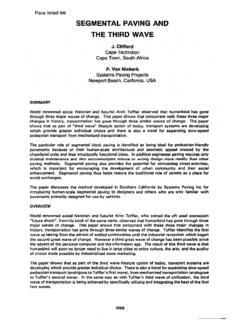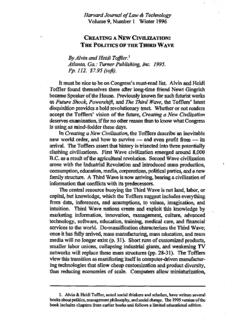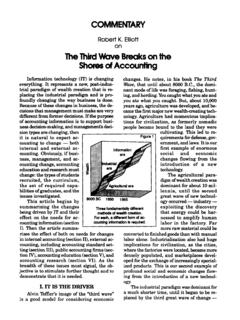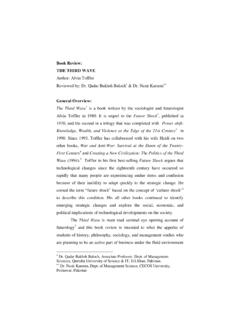Transcription of Composing Art - Office of Educational Technology
1 Composing Art Vocabulary of Art Principles of Design Unity Variety Repetition Rhythm Balance Emphasis/Focal Point Economy Proportion/Scale McGraw-Hill Higher Education, Inc. 2008 The organization of Elements is called Composition or Design. Lawrence Going Home. 1946 Unity and Variety: Color and Shape Lines of Rhythm Lines of Rhythm de Hooch. Interior of a Dutch House 1658. Unity and Variety: Pattern and Design Structural Lines Balance Visual Weight McGraw-Hill Higher Education, Inc. 2008 Symmetrical Balance: Mirror image of Shapes/Forms on either side of an imaginary axial dividing line. Elements correspond to one another in size, shape, and placement.
2 McGraw-Hill Higher Education, Inc. 2008 Emphasis: The viewer s attention will be centered more on certain parts of the composition than on others. Focal Point: A specific spot to which one s attention is directed. Subordination: A less visually interesting area. Emphasis and Subordination Degas Jockeys before the Race 1878-9. Emphasis: Directing our Eyes McGraw-Hill Higher Education, Inc. 2008 Scale: Size in relation to a constant or normal size. Proportion: Refers to size relationships between parts of a whole or between two or more items perceived as a unit. Proportion and Scale McGraw-Hill Higher Education, Inc. 2008 Proportion and Scale Egyptian.
3 Palette of Narmer. Canon of hierarchic proportion McGraw-Hill Higher Education, Inc. 2008 Leonardo daVinci, The Study of Human Proportions According to Vitruvius, c. 1485-90. Proportion and Scale Doryphorous. Polykleitos Rembrandt Self Portrait. 1630. 2 x 1 7/8 ACTUAL SIZE VERSUS PERCEIVED SIZE Oldenberg & van Bruggen. Shuttlecocks. 1994. Unexpected Proportion and Scale McGraw-Hill Higher Education, Inc. 2008 Michelangelo Pieta 1501. Master of the Beautiful Madonna. Pieta. 1415 Compositional Impact of Scale PART 1 FUNDAMENTALS Gateways to Art: Understanding the Visual Arts, Debra J. DeWitte, Ralph M. Larmann, M. Kathryn Shields Chapter Unity, Variety, and Balance Introduction Unity refers to the imposition of order and harmony on a design Variety is a kind of visual diversity that brings many different ideas, media, and elements together in one composition Balance refers to the distribution of elements, whether unified or varied, within a work PART 1 FUNDAMENTALS Gateways to Art: Understanding the Visual Arts, Debra J.
4 DeWitte, Ralph M. Larmann, M. Kathryn Shields Chapter Unity, Variety, and Balance Unity Provides an artwork with its cohesiveness and helps communicate its visual idea Artists are concerned with three kinds of unity: compositional, conceptual, and gestalt (the complete order and indivisible unity of all aspects of an artwork s design) PART 1 FUNDAMENTALS Gateways to Art: Understanding the Visual Arts, Debra J. DeWitte, Ralph M. Larmann, M. Kathryn Shields Chapter Unity, Variety, and Balance Compositional Unity An artist creates compositional unity by organizing all the visual aspects of a work Too much similarity of shape, color, line, or any single element or principle of art can be monotonous and make us lose interest Too much variety can lead to a lack of structure and the absence of a central idea PART 1 FUNDAMENTALS Chapter Unity, Variety, and Balance Gateways to Art: Understanding the Visual Arts, Debra J.
5 DeWitte, Ralph M. Larmann, M. Kathryn Shields Compositional Unity Three diagrams of compositional unity slide 1: Katsushika Hokusai, The great Wave off Shore at Kanagawa, from Thirty-Six Views of Mount Fuji, 1826 33 (printed later). Print, color woodcut. Library of Congress, Washington, slide 2: Graphics with Katsushika Hokusai, The great Wave off Shore at Kanagawa, from Thirty-Six Views of Mount Fuji, 1826 33 (printed later). Print, color woodcut. Library of Congress, Washington, PART 1 FUNDAMENTALS Gateway to Art: Chapter Unity, Variety, and Balance Gateways to Art: Understanding the Visual Arts, Debra J. DeWitte, Ralph M. Larmann, M.
6 Kathryn Shields Hokusai, The great Wave off Shore at Kanagawa A Masterpiece of Unity and Harmony Created a unified composition by organizing repetitions of shapes, colors, textures, and patterns to create a visual harmony, even though the scene is chaotic Mount Fuji (A), in the middle of the bottom third of the work, almost blends into the ocean Whitecaps on the waves (B) mimic the snow atop Mount Fuji Hokusai has also carefully selected the solids and voids in his composition to create opposing but balancing areas of interest. As the solid shape of the great wave curves around the deep trough below it (C), the two areas compete for attention, neither possible without the other Interior design, I.
7 Michael Interior Design, Bethesda, Maryland Linear evaluation of elements in interior design, I. Michael Interior Design, Bethesda, Maryland PART 1 FUNDAMENTALS Chapter Unity, Variety, and Balance Gateways to Art: Understanding the Visual Arts, Debra J. DeWitte, Ralph M. Larmann, M. Kathryn Shields Interior design, I. Michael Interior Design The interior has a balance of curved and straight lines that complement each other The linear patterns of curved lines repeat (red), as do the other directional lines Shapes are distributed throughout the scene (green) Marie Marevna (Marie Vorobieff-Stebelska), Nature morte la bouteille, 1917. Oil on canvas with plaster, 19 x 24 PART 1 FUNDAMENTALS Chapter Unity, Variety, and Balance Gateways to Art: Understanding the Visual Arts, Debra J.
8 DeWitte, Ralph M. Larmann, M. Kathryn Shields Marie Marevna (Marie Vorobieff-Stebelska), Nature morte la bouteille The unifying features are the angular lines and flat areas of color or pattern Marevna s Cubist style breaks apart a scene and re-creates it from a variety of different angles The entire work becomes unified because the artist paints a variety of different viewing angles using flat areas of color and pattern throughout Even though we view the still life from many different angles, the artist was able to unify the composition by using similar elements Piero della Francesca, The Flagellation, c. 1469. Oil and tempera on panel, 23 x 32.
9 Galleria Nazionale delle Marche, Urbino, Italy PART 1 FUNDAMENTALS Chapter Unity, Variety, and Balance Gateways to Art: Understanding the Visual Arts, Debra J. DeWitte, Ralph M. Larmann, M. Kathryn Shields Piero della Francesca, The Flagellation The artist concentrates on two major areas: foreground and background The organic human shapes in the foreground are balanced against the geometric lines of the background Rather than communicating a feeling of tension and violence, the composition is quiet and logical, emphasizing the mood of detachment and contemplation Romare Bearden, The Dove, 1964. Cut-and-pasted printed papers, gouache, pencil, and colored pencil on board, 13 x 18.
10 MOMA, New York PART 1 FUNDAMENTALS Chapter Unity, Variety, and Balance Gateways to Art: Understanding the Visual Arts, Debra J. DeWitte, Ralph M. Larmann, M. Kathryn Shields Romare Bearden, The Dove Some artists create compositional unity while gathering together bits and pieces of visual information In this work we see snippets of faces and hands, city textures of brick walls and fire escapes, and other associated images assembled into a scene that, at first glance, seems frenetic and chaotic Bearden reflects the order of the city with an underlying grid made up of verticals and horizontals in the street below, and the vertical street posts and buildings in the upper section of the work PART 1 FUNDAMENTALS Gateways to Art: Understanding the Visual Arts, Debra J.

